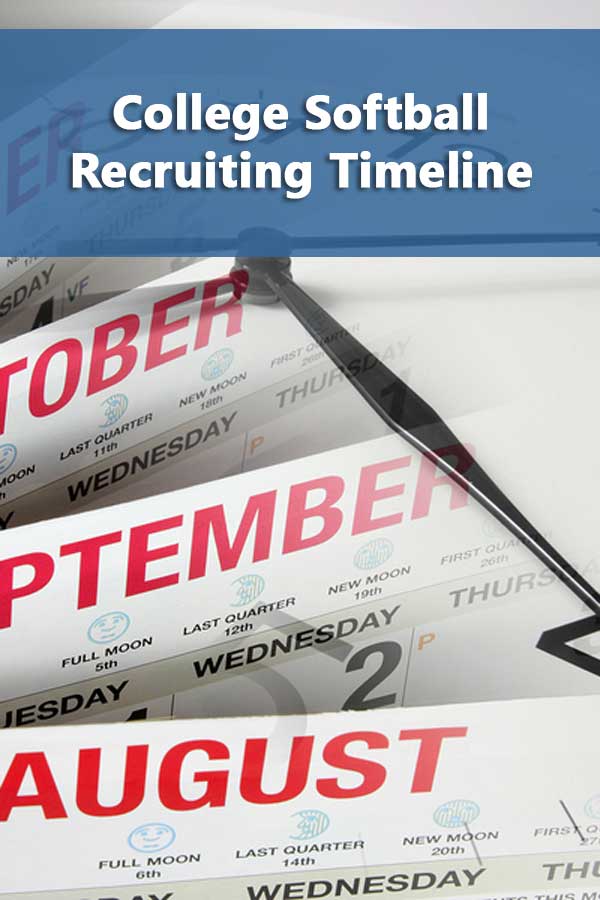 According to an NCAA survey, 43% of D1 Softball players had their first recruiting contact in ninth grade or earlier. Another 35% had their first contact as sophomores. That means over 3/4s of all D1 sophomore players are being recruited by their sophomore year. This explains why, on average, D1 Softball players make their verbal commitments before the end of their sophomore year. I’m not saying it’s right. It’s crazy as far as I’m concerned. But that means softball players need to get their recruiting act together early!
According to an NCAA survey, 43% of D1 Softball players had their first recruiting contact in ninth grade or earlier. Another 35% had their first contact as sophomores. That means over 3/4s of all D1 sophomore players are being recruited by their sophomore year. This explains why, on average, D1 Softball players make their verbal commitments before the end of their sophomore year. I’m not saying it’s right. It’s crazy as far as I’m concerned. But that means softball players need to get their recruiting act together early!
It also means that the idea that there is some paced timeline of milestones that are spread throughout the high school years for softball recruiting is smashed to smithereens outdated. Of course, there are still some published dates on when things can “formally” happen. But how much do they really matter in college softball recruiting? When D1 softball players are on average making verbal commitments during their sophomore year, how important is it to know when you can sign the National Letter of Intent (NLI).
Join other parents in the College Recruiting Parent Zone
Pay attention to the NCAA recruiting calendar
The only official timelines softball players and their families need be really concerned about is the recruiting calendar. These are the rules that regulate when during the year coaches can have contact and what kind of contact with players. These calendars change each year so players should refer to them before planning any unofficial visits to avoid.
You will probably start early
Now the reality is that if you’re going to play D3 softball, you don’t have to worry about deciding on which college to attend before you get your driver’s license. No athletic scholarships, limited recruiting budgets, and no NLI all mean that D3 coaches have little reason to start recruiting before players’ junior year.
The problem is that very few softball players enter high school thinking they’re going to end up at a D3 college. And that’s not just because of unrealistic expectations. Even among females, players have been known to make tremendous development leaps in high school. Your eighth grade playing ability is not destiny.
Unfortunately, it does mean that unless you know you want to play at a D3 college, you will probably find yourself starting the college recruiting process just as early as everyone else in softball “just in-case.”
But there are no guarantees
However, keep in mind there are no certainties. Jumping early out of fear that there won’t be more or better offers coming means you’ve just increased your chances of the head coach leaving before you ever attend your first class. Approximately a quarter of D1 athletes who committed as freshman had a different head coach by the time of enrollment. Make sure you’re committing to the school.
And while they’re in the minority, the NCAA survey found 7% of D1 Softball athletes did not verbally commit before signing the NLI. Another 15% didn’t commit until their senior year. That means around one in five D1 softball players managed to avoid the early stampede. Of course, there is no way of knowing if this was by choice or by chance.
All of this brings us back to the fact that the college softball recruiting timeline starts ridiculously early. And for those looking to compete at the D1 level, it can be compressed into a matter a few short years. Therefore, consider the following more of a checklist than a timeline.
I tried to create three different timeline tracks depending on your playing level. However, so much will depend on each player’s individual circumstance. Therefore, take the grades as loose guidelines and adapt it to your personal timeline.
College Softball Recruiting Timeline
Depending on which level you’ll play at in college, things will happen at different times. It helps to have a realistic idea of what level you’ll play at. That way you’ll be able to focus your efforts on coaches most likely to recruit you.
Indications of D1 level:
- contact by D1 coach
- invitation to try out for ASA/Junior Olympic Program
- play on an elite travelball statewide team
- play varsity as a freshman
Pink indicates recruiting timeline rules
Green items are about financial aid
Yellow indicates academic issues.
|
D1 High |
D1/ D2 |
D3/ NAIA |
Always play at highest level possible, work for the best grades possible. |
|
8 |
9 |
9 |
Download the NCAA and NAIA Athletic Recruiting Guides. You’ll need to do this every year. You don’t need to memorize it, but you should be familiar enough with it |
|
8 |
8 |
8 |
Do a search for yourself both on websites and social media. You don’t want anything showing up that undermine your chances of being recruited. Remember, coaches have plenty of choices for recruits, don’t give them any reason to eliminate you. Get in the habit of only posting things you would be willing to share with your teachers. |
|
8 |
9 |
10 |
Set up an email address to use for all recruiting. Both athlete and parents should have access to it so that nothing gets missed. |
|
8 |
9 |
10 |
Set up your voice mailbox. Check it regularly and don’t let it get full! Consider it a nice problem to have. |
|
8 |
9 |
9 |
Financial Reality Check. The largest NCAA division doesn’t allow athletic scholarships. Now is the time for families to calculate their Expected Family Contribution (EFC). Use the College Board’s EFC. While all athletes dream of full-ride scholarships, the reality is that Softball is an equivalency sport. That means scholarships can be divided among players. As for the 12 scholarships allowed per team, that’s the maximum allowed. Not all colleges full fund all available scholarships. |
|
8 |
8 |
8 |
Depending on your financial situation, this is also a good time to set a recruiting budget. How much can your family afford for unofficial visits and so on. |
|
8 |
8 |
8 |
Start unofficial visits. These don’t even have to involve contacting coaches yet. But it’s a good idea to start visiting a variety of colleges in the area so you have something to compare against. |
|
8 |
9 |
10 |
Create a list of 50 colleges to target where you think you can be recruited. Start researching a few each week. This something parents can help out. |
|
8 |
9 |
10 |
Start recording and editing video. This doesn’t have to be complicated. You can create your own with your smart phone. |
|
8 |
9 |
9 |
Target summer camps, showcases with coaches from colleges you’re interested in. If you don’t hear back from them, you’ll know to move on. Use the information from the camps to better target the appropriate division for recruiting. |
|
8 |
9 |
10 |
If you think you’re D1 level, create an athletic resume. You’re going to need it to compete questionnaires as a freshman. |
|
8 |
9 |
10 |
Create list of questions to ask coaches |
|
8 |
9 |
10 |
Start or update your athletic profile as necessary. Create an online profile, there are free options available. Make sure you include a link in your profile since this will be the place to upload your video. |
|
8 |
9 |
9 |
Keep track of camps that colleges you’re interested in are attending or hosting. Some of these will be during semester breaks, vacations, or even long weekends. |
|
8 |
9 |
9 |
Start using your college list. Contact coaches to find out what positions they’re recruiting for your class. Call coaches about actual camps your plan on attending. |
|
8 |
9 |
9 |
Continue making unofficial visits. Make sure you use the colleges Net Price Calculator so that you have a good understanding of the costs. |
|
8 |
9 |
9 |
Check how your athletic qualification/benchmarks compare to the college’s existing rooster. Use this information to improve your abilities or adjust your expectations. |
|
9 |
9 |
9 |
Let your high school counselor know that you’re interested in playing at the college level. The counselor should have a list of courses that will meet the NCAA requirements. It doesn’t hurt for parents to look up the information themselves here just to make sure there aren’t any mistakes. |
|
9 |
9 |
9 |
D3 and NAIA Coaches can start calling |
|
9 |
9 |
9 |
Get a financial aid timeline. |
|
8 |
9 |
10 |
Send updates to coaches you have already contacted. Try to use a consistent subject line for each contact, for example: Jane Smith, 20xx Prospect, update. |
|
9-10 |
9-10 |
9-10 |
Top recruits will start receiving offers |
|
10 |
10 |
10 |
Take the PSAT. This will give you an idea of how much work you need to put into test prep. |
|
10-11 |
10-11 |
10-11 |
D2 coaches can make phones calls, send mails, send text starting June 15 |
|
11 |
11 |
11 |
Coaches can start sending you recruiting material on September 1 |
|
11 |
11 |
11 |
Register with the NCAA Eligibility Center, not necessary if you’re playing D3 or NAIA |
|
11 |
11 |
11 |
Request early financial aid read if appropriate |
|
11 |
11 |
11 |
Take SAT/ACT in the fall–make sure you have the results send the NCAA |
|
11 |
11 |
11 |
Ask teachers for any required letters 0f recommendations for the fall. |
|
11-12 |
11-12 |
11-12 |
D1 Coaches can start calling once a week starting July 1, twice a week starting August 1 |
|
11-12 |
11-12 |
11-12 |
Starting July 1, up to 3 off campus contacts allowed |
|
11-12- |
11-12 |
11-12 |
Work on any required college admissions essays |
|
12 |
12 |
12 |
5 Official visits allowed for D1 colleges, unlimited for all others |
|
12 |
12 |
12 |
Let colleges know you are not interested as soon as possible. |
|
12 |
12 |
12 |
Retake SAT/ACT if needed |
|
12 |
12 |
12 |
Complete FAFSA as close to October 1st as possible, submit PROFILE if required. |
|
12 |
12 |
12 |
Early signing period 2nd Wednesday of November |
|
12 |
12 |
12 |
Make sure all letters of recommendation are submitted |
|
12 |
12 |
12 |
Submit Early Decision/Action College Application if required |
|
12 |
12 |
12 |
Regular signing period 2nd Wednesday in April |
|
12 |
12 |
12 |
Send final transcripts to the NCAA |
|
12 |
12 |
12 |
Once you accept at a school, get the team’s summer workout schedule and do it. |
|
12 |
12 |
12 |
Don’t miss any non-athletic financial aid deadlines. |
CONNECT WITH OTHER PARENTS WITH PROSPECTIVE COLLEGE ATHLETES
JOIN THE COLLEGE RECRUITING PARENT ZONE


